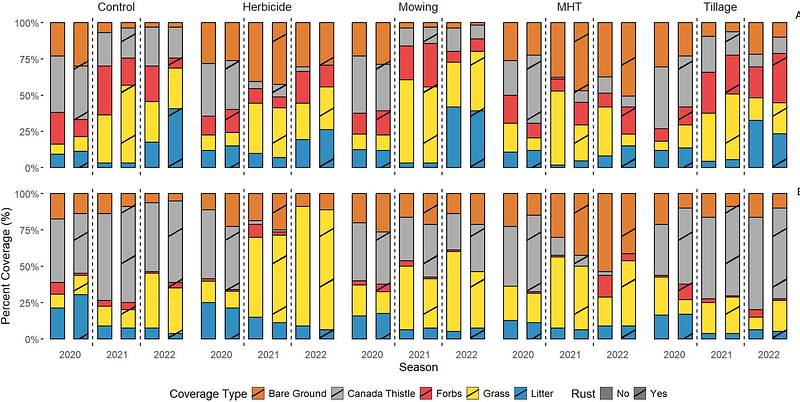Integrated management of Canada thistle (Cirsium arvense) in the Great Plains and Intermountain West using a biocontrol agent (Puccinia suaveolens)

Integrated management of Canada thistle (Cirsium arvense) in the Great Plains and Intermountain West using a biocontrol agent (Puccinia suaveolens)
Henderson, C.; Gladem, K.; Young, S. L.; Bean, D. W.; Schaeffer, R. N.
AbstractCanada thistle [Cirsium arvense (L.) Scop.] is an invasive perennial plant that threatens agricultural landscapes and natural ecosystems worldwide. The extensive regenerative root system of Canada thistle complicates control efforts, with current strategies having limited success. Puccinia suaveolens (Pers.) Rostr (syn. Puccinia punctiformis (F. Strauss) Rohl), an obligate biotrophic rust fungus, has shown potential as a biological control agent by systemically infecting the root system, reducing root mass and shoot growth, and limiting vegetative regeneration; however, its efficacy when integrated with other control methods remains unclear. We conducted experiments from 2020 to 2022 at two sites in Colorado and Utah to evaluate P. suaveolens efficacy when applied alone and in combination with mowing, tillage, and herbicide. Treatments were applied in Fall (2020 and 2021), with monitoring of thistle stem density, vegetative cover, as well as P. suaveolens incidence before and after treatments through 2022. While P. suaveolens alone contributed to a decrease in thistle density, it was less effective compared to herbicide treatments, and its impact when integrated with mowing or tillage was inconsistent. Herbicide application (alone and when combined with P. suaveolens) generated the greatest immediate reduction in thistle stem density and vegetative cover, although it resulted in the greatest amount of bare ground exposure. Grass coverage present within treated plots varied significantly between treatments, ranging from 0-75%, with the highest percentage observed in herbicide treatments compared to control and tillage in both years. Forb cover remained below 10% across treatments and years. Although P. suaveolens continues to show promise as a biological control agent, further research is needed to improve efficacy, and optimize integration with other control strategies.